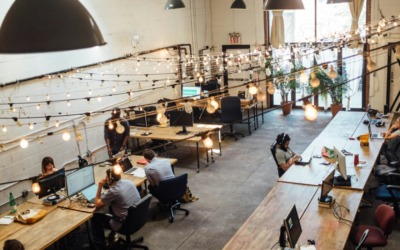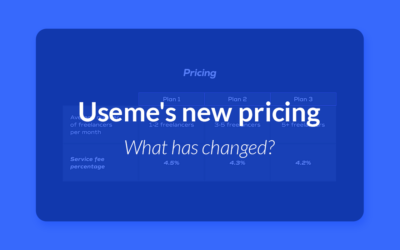This blog post with our tips on how to find a talented graphic designer apply to:
- companies offering graphic design projects and creative solutions for their clients (e.g., marketing agencies),
- executives who look for an in-house designer to communicate with their clients visually,
- individuals who need a graphic design project for private purposes.
We’re here to help you learn where and how to find the best graphic designers and handle collaboration and project management once you hire one.
Graphic design in a nutshell
Modern businesses, regardless of their size and niche, use graphic design to communicate with their audience. With digital graphics, you can convey complex messages without words, corresponding to our short attention span. In many cases, it’s easier to grasp the idea by looking at an infographic than by reading a few paragraphs of plain text.
Graphic design can serve many purposes, and a great graphic designer will help you accomplish them. It can help sell your products, promote your service, position your brand, attract, entertain, and inform your target audience, tell stories, and inspire to create new ones. In general, graphic design can move people towards specific actions. It’s also a form of art – a leading graphic designer in a company can be an art director.
The design industry has been blooming, and freelance graphic design encompasses many areas of expertise. You can find experienced designers with comprehensive skill sets and knowledge, as well as those specializing in one or a few niches.
Some of the most popular graphic assignments are:
- defining the visual identity of a brand (as an element of brand identity) – the visual representation of a company or organization, including logo design, color palette, typography, and visual elements;
- creatives used in digital marketing – e.g., graphics for social media posts and ads;
- graphic art for print media – e.g., magazines and print materials such as brochures;
- web graphics and web design – visuals used on websites, mobile apps, UX and UI designs;
- custom illustrations for companies and individual clients – e.g., posters or wedding invitations;
- packaging design.
Freelance graphic designer vs. employee
Graphic design, along with other creative professions, has seen an abundance of independent professionals who prefer working freely with diverse clients. This leaves us choosing between hiring graphic designers full-time or hiring freelancers based on assignments.
There are many scenarios when signing a traditional work contract with a senior or junior graphic designer is the best solution for your business – e.g., when you need someone on-site for eight hours straight.
If not, consider a modern and cost-effective way to outsource creative tasks and access top graphic designers who went freelance to enjoy flexibility. What’s in it for you?
- You can choose a specialist based on the project’s requirements and adjust the workload to your current needs. You pay only for what you order.
- You can easily find freelance experts in your niche. Independent specialists often have broad knowledge of their mother discipline and experience-based expertise in a specific branch, e.g., visual design, web design, brand strategy, etc.
- Not only do you save money you would spend on traditional employment but also time. Freelance graphic design doesn’t require complex recruitment, drafting work contracts, complying with the employee’s social insurance rules, etc. Instead, you can collaborate flexibly based on customized agreements and invoices.
- You don’t need to stick to local resources. Freelancing facilitates worldwide connections. If you find a foreign professional with adequate experience in graphic design and innovative ideas, it will be much easier to formalize freelance collaboration than traditional contract-based employment.
For more elaborate differences between a freelancer and an employee check our article.
Hiring graphic designers: project management, payments, and workflow
When you hire a graphic designer, think over your collaboration terms. Set clear expectations from day one to avoid misunderstandings along the way. Thanks to that, both of you can focus on your work instead of formalities and organizational matters.
Consider how you want to handle:
- Payments – to agree on payment terms, you should first define project scope, deliverables, and deadlines. Once you do it, outline the payment structure. Possible schemes include:
hourly pay,
a fixed price paid at the end of the project,
dividing the project into milestones and paying for each,
paying a deposit upfront and the rest of the sum at the end of the collaboration. - Communication – settle a communication schedule to avoid emailing back and forth all the time. Encourage a chosen graphic designer to prepare a list of questions they would like to ask before getting down to work. Agree on dates for follow-up meetings and a preferred means of periodic (e.g., Google meets) and ongoing (e.g., emails, WhatsApp) communication.
- Location – think what are your current requirements:
you need a graphic designer in your company, meaning the physical office;
you provide any space and look for a remote subcontractor;
you opt for a hybrid model and meet in intervals to review the newest graphic design.
- Contract – to avoid illegal labour, pay your graphic without any under-the-table malpractices. That usually means taking care of formalities such as contracts and accounting. The required costs and documents will differ, depending on what type of legal binding you choose – e.g., a work contract or a buy-sell agreement.
If you decide to collaborate with a freelance graphic designer, you can download our freelancer onboarding checklist prepared specifically for companies starting their collaborations with freelancers.
Where can you find good graphic designers?
There are several effective strategies to help you find employees.
Platforms for freelancers
One of the most reliable ways to find a graphic designer is through online platforms and marketplaces that connect businesses with talents. Websites such as Useme, Dribble, or Upwork gather freelance graphic designers with diverse portfolios and expertise. These platforms allow you to review their previous work, read client reviews, and directly communicate with potential candidates.
Graphic design community
Another effective method is networking within the design community. Attend industry events, join relevant online forums or communities, and engage with freelance designers. By connecting with professionals in the field, you can gain valuable insights and recommendations on finding the right graphic designer for your project.
Social media
Platforms like LinkedIn, Instagram, and Behance allow designers to showcase their work and establish an online presence. By browsing through their portfolios and engaging with their content, you can get a sense of their style and capabilities.
Your acquaintances
Don’t underestimate the power of referrals. Reach out to colleagues, friends, or business associates who have previously worked on similar projects or have experience hiring graphic designers. Their firsthand recommendations can save you time and effort in finding someone reliable.
You can also use these sources to recruit tech talents, marketing specialists, translators, copywriters, or any other freelancers.
How to find a graphic designer on Useme
Browsing through multiple platforms that connect freelancers with their clients might be overwhelming. There are dozens of services, each listing graphic design among the supported freelance professions. So why should you choose Useme over others?
First and foremost, Useme takes over all the formalities related to outsourcing graphic design to a freelancer. You don’t have to prepare a contract or stay up to date with tax, insurance, and employment regulations because Useme ensures full compliance. All you need to do is find your experienced designer and let them create. Every assignment ends with a tax invoice and, possibly, a view to further collaboration!
On Useme, you can settle deals with your current freelance graphic designer or find new talented specialists. Useme gives you access to a global talent pool and takes over the red tape-free work. Here’s how to find a graphic designer on the platform:
- To use all the features, set up a free account here.
- Go to: For employees → Find a freelancer to browse our global base of freelancers.
- Pick a category – Design – and access graphic designers ready for new assignments, be it a one-time task or an elaborate project.
- Select a subcategory (2D graphics, 3D graphics, Architecture, UX/UI design) to meet graphic designers specialized in your niche.
- Enter a profile of a chosen freelancer to see their graphic design portfolio and job experience.
- Contact candidates for your next freelance graphic designer!
Alternatively, you can post a job offer and wait for freelancers to apply. Then, you can check the profiles and portfolios of those already interested in working on your project. Once you choose a freelance graphic designer, they’ll get emailed about the deadline for submitting their design.
How much does it cost to hire a graphic designer?
As with other creative specialists, it’s hard to narrow down the rates offered by freelance graphic designers. What you can do is define factors that can impact the price and then adjust your expectations and budget.
Professional designers’ rates depend primarily on their creative activities to date. Top designers with elaborate portfolios of projects related to your needs may charge more than digital designers who have just started building their customer base and are now looking for opportunities to fill in their portfolios.
The cost of your collaboration with a freelancer also depends on the payment model you choose. You can easily find graphic designers who charge for every project and prefer assignment-based work. Or you can hire graphic designers and pay them for every hour they work (hourly pay). It’s up to you and your freelance graphic designer.
Graphic designer job description
How to find a graphic designer? Start with defining your requirements and the goals you want to reach with graphic design. You will include them in your job description.
If you already have a specific design project in mind (e.g., marketing materials), describe them in your offer. If, on the other hand, you’re not sure about the outcome, rely on your new graphic designer. Offer to discuss the project scope directly with them and center your job description on your business objectives (e.g., create a visual brand identity).
If you want to find a good graphic designer, check how to write a job description and consider including these details:
- clear deliverables and designer’s responsibilities – what graphic design you need and why you need it, how much workload you’re planning to assign, who’s the target audience;
- collaboration length – decide if it’s a one-time project, a full-time position, or a long-term creative process based on hourly pay;
- payment model preference – e.g., fixed-price contract, hourly rates, milestone-based payments;
- professional background the right graphic designer should have – e.g., familiarity with digital marketing, creating a brand’s identity, designing user interfaces, ad visuals, or social media graphics;
- familiarity with design tools – e.g., Adobe Creative Cloud (Adobe Photoshop, Adobe Illustrator, InDesign), Figma, Corel;
- suitability to work as a team member or as an individual – if you hire several graphic designers, you should mention your team’ working style and the stage of the project (if the new graphic designer would join an evolving one);
- strong communication skills – to discuss project details and adjust graphics to your company culture and brand guidelines;
- organizational matters – e.g., your approach to remote or hybrid work.
For more tips, check out our related guide on how to write an administrative assistant job description.
How to evaluate a graphic designer’s portfolio
After posting a job offer and screening promising candidates for a good graphic designer, look closer at their portfolios. Relevant education and soft skills are necessary, but it’s the graphic designers’ past works that illustrate their suitability for the job.
One of the mistakes made by managers is not defining expectations and criteria earlier on. Here are our suggestions on what you can assess in a graphic designer’s portfolio:
- Design skills: Look for technical proficiency in design software and tools. Evaluate their ability to create visually appealing layouts, use color effectively, and demonstrate strong typography skills.
- Creativity: Assess the originality and uniqueness of their designs. A great graphic designer should have a knack for thinking beyond well-known schemes and bringing fresh ideas to the table.
- Visual communication: Consider how well the designer communicates messages through visuals. Look for clarity, coherence, and effectiveness in conveying information or evoking emotions through their designs.
- Versatility: Determine if a designer can adapt their style to different projects or industries. A diverse portfolio demonstrates flexibility and an ability to cater to various design needs.
- Attention to detail and consistency: Scrutinize their work for precision and meticulousness in elements such as alignment, spacing, and consistency across different design elements.
How to find a graphic designer – interview and trial project
Portfolios will help you shortlist candidates but don’t base your choice on their past works alone. Ask chosen freelancers about their design process. You will get to know more about their approach to work and creativity level, but also about their personality and communication skills. Talking to a graphic designer, you’ll see if you understand each other. Consider arranging a video chat.
When interviewing graphic designers, include also your input. Ask a candidate how you can contribute to their work to achieve the best possible results. Talk about your industry, brand identity, target audience, and any other relevant information for the project.
One more way of checking if you’re a match is by offering a trial graphic design. It can require creating a graphic from scratch or tweaking a prior project. Remember that candidates should be paid for trial runs.
Create a brief for graphic designers
Templates automate your work and simplify communication with business partners. To save time and focus less on operational tasks and more on the actual work, prepare a reusable brief for your future graphic designer.
If you plan to run various projects, e.g., a logo, UX, ads, social media posts, marketing materials, e-books, or web design, it’ll be helpful to draft several briefs. Otherwise, you can create one but more general template and use it for every design. The point is to streamline your work as much as possible.
Check these websites with tips and sample design briefs for inspiration:
- Smartsheet,
- Notion,
- Figma,
- Canva,
- Asana.
Wrap-up: 10 foolproof steps to find a great graphic designer
Now you know how important it is to incorporate the right graphic designer into your project. Let’s sum up all the necessary steps for finding the perfect match!
- Define your project requirements and business goals you want to accomplish with your new graphic design.
- Determine work scope, project length, and budget.
- Think through organizational matters, such as follow-up meetings and feedback, payment terms, project management, deadlines, etc.
- Summarize crucial points from the previous steps and write a job description.
- Explore freelancer websites and send offers to promising candidates, or post a job offer and wait for applications to flow in.
- Revise portfolios in terms of past projects and expertise in relevant design tools.
- Prepare a list of questions you’ll ask during a video interview or via email.
- Select freelancers for a small and paid trial project.
- Choose the winner and fill in a brief for the first graphic design you want to assign to your new contractor.
- Embark on your new business journey with an experienced, skilled, and communicative graphic designer on board.
We’re crossing our fingers for you and your future freelance graphic designer!





